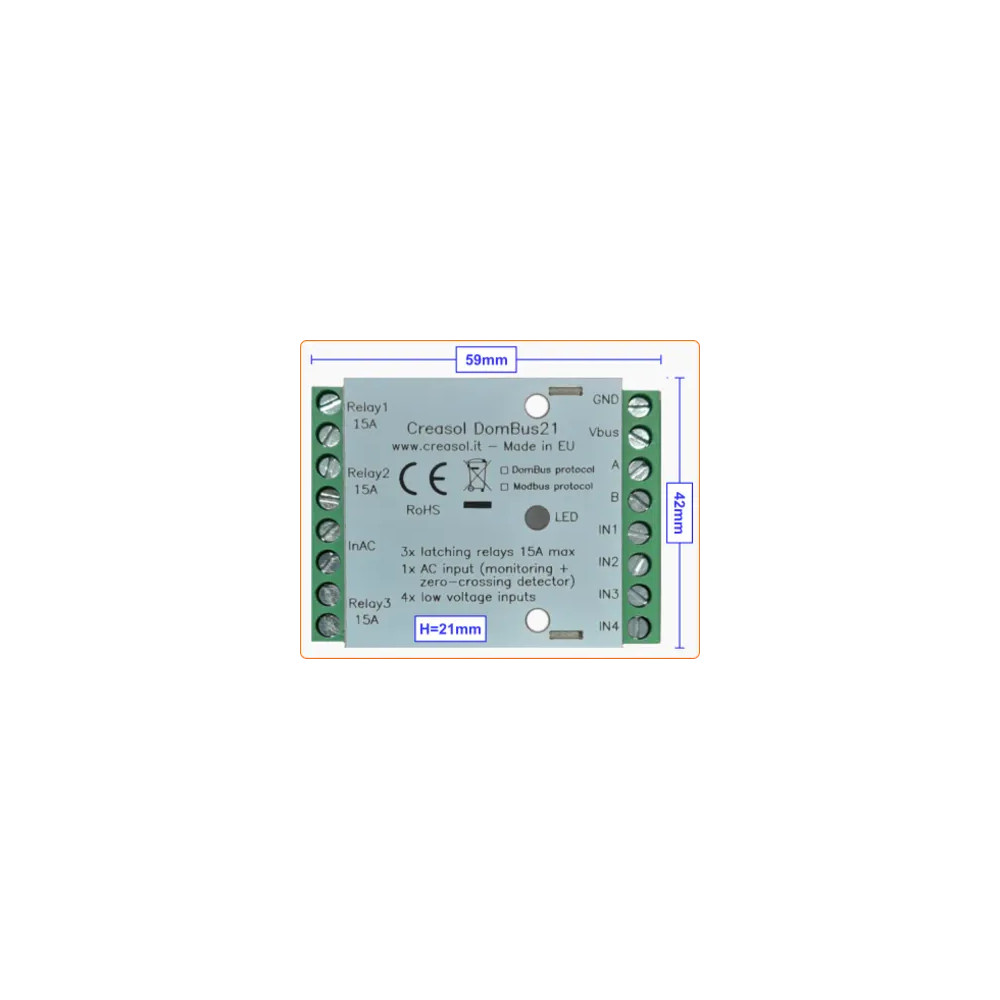
Creasol DomBusTH - Domoticz-enhet med temperatur- og fuktighetssensorer, 4 innganger, 2 utganger, 3 lysdioder
- På salg!
- -25%
Email: store@creasol.it - Telegram: CreasolTech - Whatsapp: +393283730010
Prioritert post: raskt og billig - Express Courier: raskt
Kontakt oss før du returnerer produkter!

Meget kompakt og lavt strømforbruk modul med 3 releer 15A, 1 AC-inngang, 4 analoge/digitale innganger.
 Full support: most products are designed by us!
Full support: most products are designed by us!
Email: store@creasol.it - Telegram: CreasolTech - Whatsapp: +393283730010
 Bestillinger sendes innen 1 virkedag
Bestillinger sendes innen 1 virkedag
Prioritert post: raskt og billig - Express Courier: raskt
 24 måneders garanti, enkel retur/refusjon
24 måneders garanti, enkel retur/refusjon
Kontakt oss før du returnerer produkter!
Pålitelig laveffekt domotikkmodul designet for å aktivere/deaktivere belastninger som sparer energiforbruk, og nullstiller standby-strømmen.
 Den bruker 3 låsereléer, 15A 250Vac, som ikke bruker noe når de er aktive, og kan brukes til aktivere belastninger eller generatorer opp til 3kW som er AV i lang tid. Også, fjerning av strøm til laster under tordenvær bidrar til å forhindre skade fra elektrostatiske utladninger.
Den bruker 3 låsereléer, 15A 250Vac, som ikke bruker noe når de er aktive, og kan brukes til aktivere belastninger eller generatorer opp til 3kW som er AV i lang tid. Også, fjerning av strøm til laster under tordenvær bidrar til å forhindre skade fra elektrostatiske utladninger.
Den har også 1 AC-inngang for å registrere 230Vac spenning (oppdager strømbrudd), som også fungerer som en nullkryssdetektor som tillater å aktivere releer når spenningen er null (til minimer rushstrøm ved kapasitive belastninger) og deaktiver releer når strømmen er null (til minimer overspenning ved induktive belastninger).
4 lavspenningsinnganger, som kan konfigureres som analog eller digital, tillat å koble til trykknappbrytere, NTC termiske prober, alarmsensorer og energi/gass/vannmålere med pulsutgang.
De 3 låsereléene kan brukes til å aktivere/deaktivere:
Standardadresse: 0xff21
| Havn# | Navn | Evner | Standardkonfigurasjon | Beskrivelse |
| 1 | RL1 | OUT_DIGITAL | OUT_DIGITAL | SPST 15A låserelé: spolen aktiveres kun under på/av-overganger, og bruker ingenting når reléet er PÅ eller AV. INAC-inngangen bør kobles til 230Vac for å tillate nullkryssdeteksjon, unngå høy innløpsstrøm (for kapasitive belastninger) og overspenning (for induktive belastninger) |
| 2 | RL2 | OUT_DIGITAL | OUT_DIGITAL | SPST 15A låserelé: spolen aktiveres kun under av/på-overganger, og bruker ingenting nårrelé er PÅ eller AV. INAC-inngangen bør kobles til 230Vac for å tillate nullkryssdeteksjon, unngå høy innløpsstrøm (for kapasitive belastninger) og overspenning (for induktive belastninger) |
| 3 | RL3 | OUT_DIGITAL | OUT_DIGITAL | SPST 15A låserelé: spolen aktiveres kun under på/av-overganger, og bruker ingenting når reléet er PÅ eller AV. INAC-inngangen bør kobles til 230Vac for å tillate nullkryssdeteksjon, unngå høy innløpsstrøm (for kapasitive belastninger) og overspenning (for induktive belastninger) |
| 4 | INAC | IN_AC, IN_COUNTER | IN_AC | Optoisolert inngang, som kan kobles til en strømbryter (for å varsle strømbrudd, spesielt for kjøleskap og varmepumper), PIR-er med 230V-utgang (for å overvåke tilstedeværelse), lys og apparater (for å overvåke når lys eller enheter er PÅ)./td> |
| 5 | IN1 | IN_DIGITAL, IN_DIGITAL_PULLDOWN, IN_ANALOG, IN_TWINBUTTON, IN_COUNTER | IN_DIGITAL | Analog eller digital inngang, med valgfri 10k pullup (pcb jumper) og valgfri intern pulldown (aktivert når konfigurert som IN_DIGITAL_PULLDOWN). Felles rekkeklemme er GND: trykknapp, bryter, tvillingknapp (dobbeltknapp med 10k motstand mellom knappene), alarmsensor, 10k NTC termistor, teller med pulsutgang (energimåler, gassmåler, vannmengdemåler), ... skal tilkobles til denne inngangen og til GND. |
| 6 | IN2 | IN_DIGITAL, IN_DIGITAL_PULLDOWN, IN_ANALOG, IN_TWINBUTTON, IN_COUNTER | IN_DIGITAL | Analog eller digital inngang, med valgfri 10k pullup (pcb jumper) og valgfri intern pulldown (aktivert når konfigurert som IN_DIGITAL_PULLDOWN). Felles rekkeklemme er GND: trykknapp, bryter, tvillingknapp (dobbeltknapp med 10k motstand mellom knappene), alarmsensor, 10k NTC termistor, teller med pulsutgang (energimåler, gassmåler, vannmengdemåler), ... skal tilkobles til denne inngangen og til GND. |
| 7 | IN3 | IN_DIGITAL, IN_DIGITAL_PULLDOWN, IN_ANALOG, IN_COUNTER | IN_DIGITAL | Analog eller digital inngang, med intern pullup eller pulldown (aktivert når konfigurert som IN_DIGITAL_PULLDOWN). Felles rekkeklemme er GND: trykknapp, bryter, alarmsensor, teller med pulsutgang (energimåler, gassmåler, vannmengdemåler), ... skal kobles til denne inngangen og til GND. |
| 8 | IN4 | IN_DIGITAL, IN_DIGITAL_PULLDOWN, IN_ANALOG, IN_COUNTER | IN_DIGITAL | Analog eller digital inngang, med intern pullup eller pulldown (aktivert når konfigurert som IN_DIGITAL_PULLDOWN). Felles rekkeklemme er GND: trykknapp, bryter, alarmsensor, teller med pulsutgang (energimåler, gassmåler, vannmengdemåler), ... skal kobles til denne inngangen og til GND. |
Ved oppstart viser modulen på rød LED gjeldende Modbus slaveadresse (registeradresse=8192) i desimalformat, på grønn LED serielle baudrate (reg. 8193), og til slutt på rød LED seriepariteten (reg. 8194 ).
Hvis en verdi er null, avgis et langt blink.
For eksempelhvis reg(8192)=33, reg(8193)=0, reg(8194)=0, vil følgende lysdiode blinker ved strøm:
3 røde blink, pause, 3 røde blink (slaveadresse= 0x21 = 33 desimal), pause, 1 lang grønn blink (reg(8193)=0 => baudrate=115200bps), pause, 1 lang rød blink (reg(8194) =0 => paritet=Ingen).
Enheten vil bare være operativ når adresse/baudrate/paritetsparametere er vist: da vil modulen godta kommandoer fra Modbus RTU, og viser periodisk utgangsstatus for alle porter, fra 1 til maks port: grønt blink betyr at portstatus er Av, rød flash betyr at porten er på.
Standard slaveadresse: 33 (0x21)
| Adr | Navn | Verdier | Beskrivelse |
| 0 | RL1 | 0=AV, 1 eller 65280=PÅ, 2-65279=PÅ for spesifisert tid. Logikk kan inverteres ved å spesifisere INVERTED-alternativet (på adresse 512+port) |
SPST 15A låserelé: spolen aktiveres kun under på/av-overganger, og bruker ingenting når reléet er PÅ eller AV. INAC-inngangen bør kobles til 230Vac for å tillate nullkryssdeteksjon, og unngå høy inn-rushstrøm (for kapasitive belastninger) og overspenning (for induktive belastninger) |
| 1 | RL2 | 0=AV, 1 eller 65280=PÅ, 2-65279=PÅ for spesifisert tid. Logikk kan inverteres ved å spesifisere INVERTED-alternativet (på adresse 512+port) |
SPST 15A låserelé: spolen aktiveres kun under på/av-overganger, og bruker ingenting når reléet er PÅ eller AV. INAC-inngangen bør kobles til 230Vac for å tillate nullkryssdeteksjon, unngå høy innløpsstrøm (for kapasitive belastninger) og overspenning (for induktive belastninger) |
| 2 | RL3 | 0=AV, 1 eller 65280=PÅ, 2-65279=PÅ for spesifisert tid. Logikk kan inverteres ved å spesifisere INVERTED-alternativet (på adresse 512+port) |
SPST 15A låserelé: spolen aktiveres kun under på/av-overganger, og bruker ingenting når reléet er PÅ eller AV. INAC-inngangen bør kobles til 230Vac for å tillate nullkryssdeteksjon, unngå høy innløpsstrøm (for kapasitive belastninger) og overspenning (for induktive belastninger) |
| 3 | INAC | 0=AV (flytende), 1=PÅ (100-250V signal oppdaget) | Optoisolert inngang, som kan kobles til en strømbryter (for å varsle strømbrudd, spesielt for kjøleskap og varmepumper), PIR-er med 230V-utgang (for å overvåke tilstedeværelse), lys og apparater (for å overvåke når lys eller enheter er PÅ)./td> |
| 4 | IN1 | 0=AV, 1=PÅ eller 0-65535 hvis porten er konfigurert som analog. Se nedenfor for mer informasjon. |
Analog eller digital inngang, med valgfri 10k pullup (pcb jumper) og valgfri intern pulldown (aktivert når konfigurert som IN_DIGITAL_PULLDOWN). Felles rekkeklemme er GND: trykknapp, bryter, tvillingknapp (dobbeltknapp med 10k motstand mellom knappene), alarmsensor, 10k NTC termistor, teller med pulsutgang (energimåler, gassmåler, vannmengdemåler), ... skal tilkobles til denne inngangen og til GND. |
| 5 | IN2 | 0=AV, 1=PÅ eller 0-65535 hvis porten er konfigurert som analog. Se nedenfor for mer informasjon. |
Analog eller digital inngang, med valgfri 10k pullup (pcb jumper)og valgfri intern rullegardin (aktivert når den er konfigurert som IN_DIGITAL_PULLDOWN). Felles rekkeklemme er GND: trykknapp, bryter, tvillingknapp (dobbeltknapp med 10k motstand mellom knappene), alarmsensor, 10k NTC termistor, teller med pulsutgang (energimåler, gassmåler, vannmengdemåler), ... skal tilkobles til denne inngangen og til GND. |
| 6 | IN3 | 0=AV, 1=PÅ eller 0-65535 hvis porten er konfigurert som analog. Se nedenfor for mer informasjon. |
Analog eller digital inngang, med intern pullup eller pulldown (aktivert når konfigurert som IN_DIGITAL_PULLDOWN). Felles rekkeklemme er GND: trykknapp, bryter, alarmsensor, teller med pulsutgang (energimåler, gassmåler, vannmengdemåler), ... skal kobles til denne inngangen og til GND. |
| 7 | IN4 | 0=AV, 1=PÅ eller 0-65535 hvis porten er konfigurert som analog. Se nedenfor for mer informasjon. |
Analog eller digital inngang, med intern pullup eller pulldown (aktivert når konfigurert som IN_DIGITAL_PULLDOWN). Felles rekkeklemme er GND: trykknapp, bryter, alarmsensor, teller med pulsutgang (energimåler, gassmåler, vannmengdemåler), ... skal kobles til denne inngangen og til GND. |
| 256-273 | Portkonfig | 1=OUT_DIGITAL, 2=OUT_RELAY_LP, ... |
Kommando som brukes til å konfigurere port 1 (256), port 2 (257), ... som OUT_DIGITAL eller OUT_RELAY_LP (lavt strømforbruk relé) eller annen verdi (se tabellen nedenfor) |
| 512-529 | Port alternativ | 0=NORMAL, 1=INVERTERT (utgang er normalt PÅ, eller inngang er PÅ når portspenningen er 0V) | Angi portalternativ. Hvis satt til 1, forblir utgangen PÅ etter oppstart til porten er bekreftet (da går reléene AV). For innganger, innstilling INVERTERT er portverdien PÅ (1) når inngangsspenningen er 0V, AV når inngangen er åpen med intern pullhigh aktivert. |
| 8192 | Slaveadresse | 1-247 | Tillatelse til å endre slaveadressen til modulen, slik at det er mulig å legge til andre moduler tilsamme buss |
| 8193 | Seriell bitrate | 0=115200 bps, 1=57600, 2=38400, 3=19200, 4=9600, 5=4800, 6=2400, 7=1200bps | Seriell hastighet, standard 115200 bps 8,n,1 |
| 8194 | Seriell paritet | 0=Ingen, 1=partall, 2=oddetall | Seriell paritet, standard ingen (115200 bps 8,n,1) |
| 8198 | Revisjon, major | Kun lesetilgang | Få fastvareversjon, hovednummer. For eksempel betyr "02" at revisjon er "02XX" der XX er definert av parameter 8199 |
| 8199 | Revisjon, mindre | Kun lesetilgang | Få fastvareversjon, mindre tall. For eksempel betyr "h1" at revisjon er "XXh1" der XX er definert av parameter 8198 |
Det er mulig å aktivere en eller flere utganger forra en viss tid (monostabil/timerutgang) som angitt i tabellen. Parameteren som tilsvarer nødvendig tid kan beregnes ved å bruke følgende regler:
Fra 0 til 60s => 31,25ms oppløsning 2=62,5ms, 3=93,75ms, ... 1920=60s => verdi=tid_i_millisekunder/31,5
Fra 1m til 1t med 1s oppløsning 1921=61s, 3540+1920=5460=1t => verdi=(time_in_seconds-60)+1920
Fra 1t til 1d med 1m oppløsning 5461=1t+1m, 1380+5460=6840=24t => verdi=(tid_i_minutter-60)+5460
Fra 1d til 1500 dager med 1t oppløsning 6841=25t, 6842=26t, og så videre => verdi=(tid_i_timer-24)+6840
Følgende tabeller viser noen eksempler på Modbus-kommandoer.
| Slaveadr | Func. Kode | Reg.Addr | Reg.verdi | Ramme | Beskrivelse |
| 55 | 06 | 8192 | 1 | [37][06][20][00][00][01][xx][xx] | Endre slaveadresse fra 54 (0x36) til 1 |
| 01 | 06 | 8193 | 4 | [01][06][20][01][00][04][D2][09] | Sett seriell hastighet til 9600bps |
| 01 | 06 | 8194 | 1 | [01][06][20][02][00][01][E2][0A] | Sett jevn paritet |
| 49 | 10 | 8192 | 1,4,1 | [31][10][20][00][00][03][06][00][01][00][04][00][01][B1][71] | Med en enkelt kommando,sett slaveadressen til 1, seriell hastighet til 9600bps, jevn paritet. Opprinnelig moduladresse var 49 (0x31) i dette eksemplet. |
| 01 | 06 | 0 | 65280 | [01][06][00][00][FF][00][C8][3A] | Aktiver RL1-utgang for alltid (65280=0xff00) |
| 01 | 06 | 1 | 960 | [01][06][00][01][03][C0][D8][AA] | Aktiver RL2 i 960/32=30s |
| 01 | 06 | 255 | 0 | [01][06][00][FF][00][00][B9][FA] | Deaktiver alle utganger (Reg.Addr=255) |
| 01 | 10 | 0 | 32,0,0,65280 | [31][10][00][00][00][04][08][00][20][00][00][00][00][FF][00][E6][5C ] | Sett RL1 på i 1 s (32), RL2 av, RL3 av, RL4 på - Maks 10 registre kan settes i én kommando |
| 01 | 03 | 255 | 1 | [01][03][00][FF][00][01][B4][3A] | Les en 16-bits verdi med portstatus. Hvis for eksempel returnert verdi er 0xd1 (0b11010001), er utdatastatusen: RL8=På, RL7=På, RL6=Av, RL5=På, RL4=Av, RL3=Av, RL2=Av, RL1=På |
| 01 | 03 | 8198 | 2 | [01][03][20][06][00][02][2F][CA] | Les 4 byte i modulversjonen. Hvis for eksempel returnert verdi er <30><32><68><31> (i hex-format), er den tilsvarende ASCII-verdien "02h1" (fastvare 02h1) |
| 01 | 0F | 0 | 8,1,0xd1 | [01][0F][00][00][00][08][01][D1][3E][C9] | Sett spolestatus til 0xd1 (0b11010001), aktiver RL8, RL7, RL5, RL1 og deaktiver andre releer |
| 01 | 01 | 0 | 8 | [01][01][00][00][00][08][3D][CC] | Les spolestatus. Hvis den returnerte verdien er 0xd1 (0b11010001), betyr det at RL8, RL7, RL5 og RL1 er på |
Modbus-protokollen kan enkelt testes ved hjelp av et modbus-program, som mbpoll for Linux:
mbpoll -v -m rtu -0 -1 -a1 -b115200 -Pingen -r 0 /dev/ttyUSB0 32 0 64 128 0 0 0 65280
for å aktivere RL1 for 1s, R3 for 2s, RL4 for 4s og RL8 for alltid.
mbpoll -v -m rtu -0 -1 -a1 -b115200 -Pingen -r 255 -c 1 /dev/ttyUSB0
for å lese alle havnestater.
Varmepumper kan ha et strømforbruk i standby på 5W eller mer: de forblir på lenge, men forblir også av i svært lang tid, så det er fornuftig å aktivere varmepumpens strømforsyning bare når det er nødvendig.
Følgende diagram viser hvordan du administrerer varmepumpen med DomBus21-modulen for å få følgende funksjoner på hjemmeautomatiseringssystemet ditt:
Energiforbruket til DomBus21 er omtrent 15mW selv med reléene på: vurderer varmepumpen På i 66% av tiden, den energi spart er ca 25kWh/år sammenlignet med et system hvor varmepumpen alltid er drevet og bruker ineffektive hjemmeautomasjonsrelémoduler!
Også, å ha varmepumpen frakoblet kan forhindre skader ved 230V spenningssvingninger eller elektrostatiske utladninger.
Vær forsiktig med ledninger: DomBus21 håndterer belastninger med maks 15A (3,5kW), som kan overopphetes eller brenne ut hvis tilkoblingene ikke gjøres riktig. Høyeffekttilkoblinger må overvåkes med et IR termisk kamera for å sikre at de ikke overopphetes når de leverer høy effekt.

The following video shows a presentation of some domotic modules designed and produced in Italy by Creasol to make a reliable, easy and power-optimized home automation system.
The next video shows our Smart EVSE module that can be used to charge the electric car by using only solar power, or adding 25/50/75/100% of available power from the electrical grid.
Our industrial and home automation modules are designed to be
Modules are available in two version:
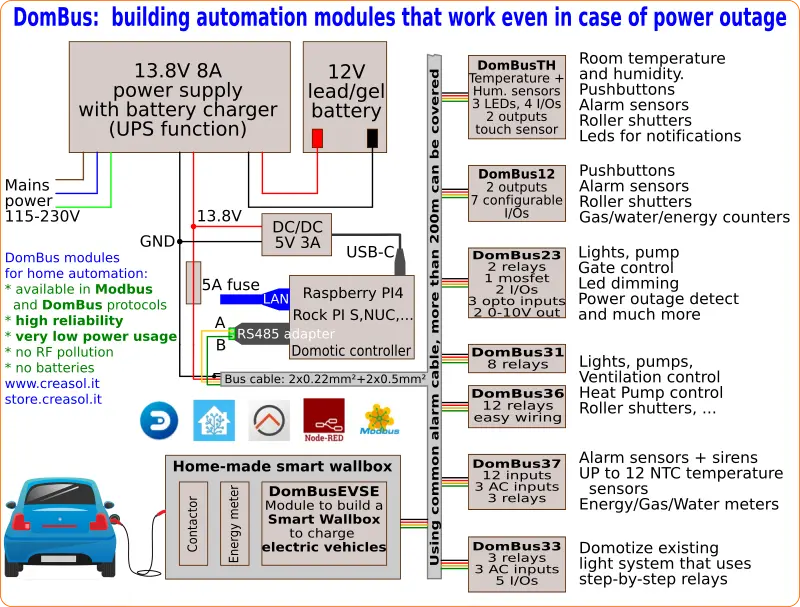
Store website - Information website
For our products we can offer FULL SUPPORT and CUSTOMIZATION: please contact us by Email or Telegram
 Complete solution to make a Smart EVSE, charging the electric vehicle using only energy from renewable source (photovoltaic, wind, ...), or adding 25-50-75-100% of available power from the grid.
Complete solution to make a Smart EVSE, charging the electric vehicle using only energy from renewable source (photovoltaic, wind, ...), or adding 25-50-75-100% of available power from the grid.
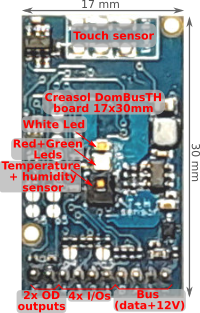 Compact board, 32x17mm, to be installed on blank cover with a 4mm hole in the middle, to exchange air for the relative humidity sensor. It can be installed in every room to monitor temperature and humidity, check alarm sensors, control blind motor UP/DOWN, send notifications (using red and green leds) and activate white led in case of power outage.
Compact board, 32x17mm, to be installed on blank cover with a 4mm hole in the middle, to exchange air for the relative humidity sensor. It can be installed in every room to monitor temperature and humidity, check alarm sensors, control blind motor UP/DOWN, send notifications (using red and green leds) and activate white led in case of power outage.
Includes:
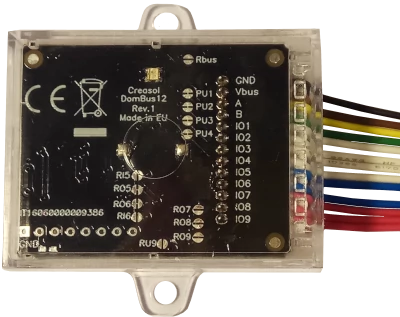 Very compact, versatile and cost-effective module with 9 ports. Each port can be configured by software as:
Very compact, versatile and cost-effective module with 9 ports. Each port can be configured by software as:
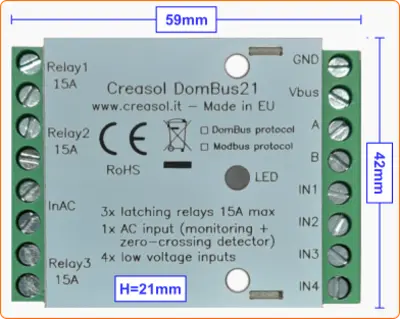 Very low power consumption module designed to enable up to 3 high power loads, up to 15A (3kW).
Very low power consumption module designed to enable up to 3 high power loads, up to 15A (3kW).
 Versatile module designed to control gate or garage door.
Versatile module designed to control gate or garage door.
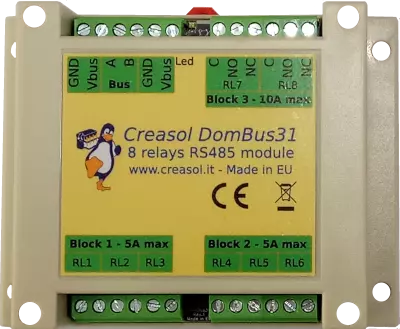 DIN rail low profile module, with 8 relays and very low power consumption:
DIN rail low profile module, with 8 relays and very low power consumption:
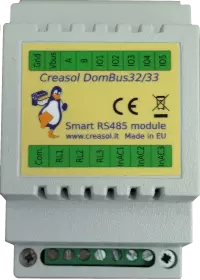 Versatile module with 230V inputs and outputs, and 5 low voltage I/Os.
Versatile module with 230V inputs and outputs, and 5 low voltage I/Os.
 Module designed to control 3 lights already existing and actually controlled by 230V pushbuttons and step-by-step relays. In this way each light can be activated by existing pushbuttons, and by the domotic controller.
Module designed to control 3 lights already existing and actually controlled by 230V pushbuttons and step-by-step relays. In this way each light can be activated by existing pushbuttons, and by the domotic controller.
Each relay can toggle the existing step-relay, switching the light On/Off. The optoisolator monitors the light status. The 5 I/Os can be connected to pushbuttons to activate or deactivate one or all lights.
 DIN rail module, low profile, with 12 relays outputs and very low power consumption.
DIN rail module, low profile, with 12 relays outputs and very low power consumption.
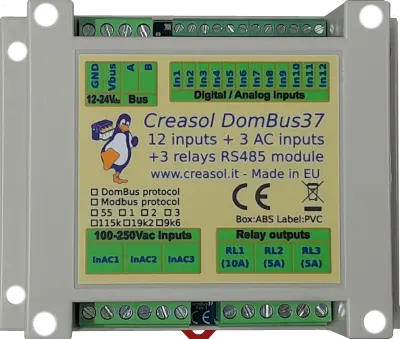 Module designed to be connected to alarm sensors (magnetc contact sensors, PIRs, tampers): it's able to monitor mains power supply (power outage / blackout) and also have 3 relays outputs.
Module designed to be connected to alarm sensors (magnetc contact sensors, PIRs, tampers): it's able to monitor mains power supply (power outage / blackout) and also have 3 relays outputs.
 DIN rail module designed for burglar alarm system.
DIN rail module designed for burglar alarm system.
![]() DIN rail module that control azimuth + elevation/tilt motors of a sun tracker, to maximize photovoltaic energy production during the day and seasons.
DIN rail module that control azimuth + elevation/tilt motors of a sun tracker, to maximize photovoltaic energy production during the day and seasons.
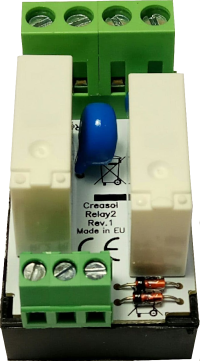 Simple module with 2 relays, to be used with DomBus modules or other electronic boards with open-collector or open-drain outputs
Simple module with 2 relays, to be used with DomBus modules or other electronic boards with open-collector or open-drain outputs
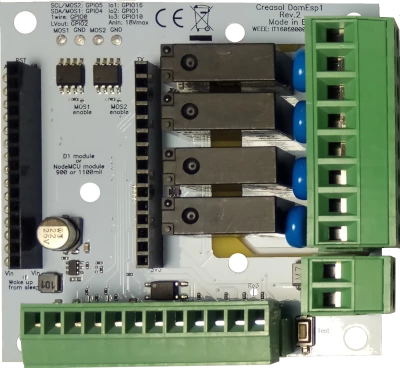 IoT board designed for NodeMCU v3 board using ESP8266 WiFi microcontroller
IoT board designed for NodeMCU v3 board using ESP8266 WiFi microcontroller